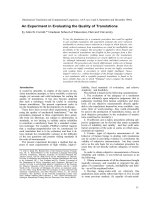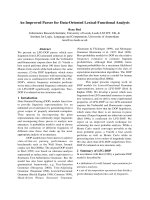Báo cáo khoa học: " An Input Device for the Harvard Automatic Dictionary" pot
Bạn đang xem bản rút gọn của tài liệu. Xem và tải ngay bản đầy đủ của tài liệu tại đây (331.33 KB, 6 trang )
[
Mechanical Translation
, vol.5, no.1, July 1958; pp. 2-7]
An Input Device for the Harvard Automatic Dictionary
†
Anthony G. Oettinger, Computation Laboratory,
Harvard University, Cambridge, Massachusetts
A standard input device has been adapted to permit transcription of either Roman
or Cyrillic characters, or a mixture of both, directly onto magnetic tape. The
modified unit produces hard copy suitable for proofreading, and records informa-
tion in a coding system well adapted to processing by a central computer. The cod-
ing system and the necessary physical modifications are both described. The de-
sign criteria used apply to any automatic information-processing system, although
specific details are given with reference to the Univac I. The modified device is
performing satisfactorily in the compilation and experimental operation of the
Harvard Automatic Dictionary.
THE PROPERTIES of a given automatic
information-processing machine depend prima-
rily on the algorithms the machine is capable
of applying to the tokens
1
for the abstract ele-
ments it is said to process. Configurations of
the states of sets of two-state devices, or
pulse trains where pulses are present or absent
in definite time intervals, are commonly used
as tokens in contemporary machines. Abstract
elements, e.g., the integers, are named by
symbols of various kinds. For example, the
numerals "2", "II", and "10" all name the
number 2. Likewise, various symbols can be
used to name tokens. It is a useful and widely
accepted convention to use the symbol "0" as
the name for one state of a two-state device,
and the symbol "1" as a name for its other state.
Frequently, the symbols "0" and "1" are used
also as binary numerals. In a context where
both these usages occur, a string such as "1001"
† This work has been supported in part by
the Harvard Foundation for Advanced Study and
Research, the United States Air Force, and the
National Science Foundation.
1. This term was originated by C. S. Peirce.
For an explanation of the underlying distinc-
tions, see H. Reichenbach, Elements of Sym-
bolic Logic, Macmillan, New York, 1947, p.4.
functions homographically both as a name for
the number 9 and as a name for a particular
configuration of a set of four two-state devices.
This practice is confusing in discourse about
machines intended for or adapted to purposes
other than numerical computation, especially
when the relation between machine tokens and
abstract elements is the chief subject of discus-
sion. In this paper, therefore, "0" and "1" will
be used exclusively as the names of tokens.
The mapping between machine tokens and the
abstract elements a given machine is said to
process can be regarded as defined by the input
and output hardware of the machine. For ex-
ample, if a pulse train 1010100 is to be re-
garded as a token for the letter A, it is desir-
able to arrange matters so that such a pulse
train will cause a printer to print the literal "A".
When an order relation exists among the tokens
in a machine, as imposed, for example, by com-
parison and branch instructions, and when the
abstract elements themselves are an ordered
set, it is usually desirable to relate abstract
elements and tokens by an order-preserving
mapping. For example, in a machine designed
to recognize 1010100 to be "smaller" than
0010101 and 0010101 in turn to be smaller
than 0010110, the mapping A — 1010100,
B — 0010101, C — 0010110 preserves normal
alphabetic order, whereas A — 0010101,
B — 1010100, C — 0010110 does not.
An Input Device 3
The Univac I computer is currently in use at
the Harvard Computation Laboratory in connec-
tion with the development of an operating auto-
matic dictionary
2
and for basic research on
the problems of automatic translation from
Russian into English. The normal mapping be-
tween numbers, letters of the Roman alphabet,
punctuation marks, and other standard symbols
on the one hand, and machine tokens on the other,
is given in Figure 2 by the columns headed
"Upper Case" and "Binary Code" (except for
key no. 0). This mapping is established by all
input and output devices associated with the
machine, in particular by the Unityper, which
is used to record information onto magnetic
tape, and by the High-Speed Printer, which is
the major output unit. Thus, when an A is
typed, a token 1010100 is recorded, and such
a token will in turn cause the High-Speed
Printer to print an A.
Adapting a machine like the Univac to handle
Cyrillic letters is conceptually a trivial matter.
To permit alphabetization of Cyrillic material,
an order-preserving mapping between the Cy-
rillic alphabet and Univac tokens is necessary.
Many such mappings can readily be established.
Once this has been done, the internal operation
of the machine with Cyrillic material presents
no difficulties. However, unless the input and
output devices are physically altered, certain
practical problems obviously arise.
Keyboard Layout
Figure 1
2. Oettinger, A. G., Foust, W., Giuliano, V.,
Magassy, K., Matejka, L., "Linguistic and
Machine Methods for Compiling and Updating
the Harvard Automatic Dictionary" (To be pre-
sented at the International Conference on Scien-
tific Information, Washington D.C., November
1958, and published in the Proceedings of the
conference).
As a first step, it is simple to cover the keys
on the Unityper with keytops labelled with Cy-
rillic letters. From the point of view of typing
ease and accuracy the most desirable keyboard
layout (Fig. 1) is one in standard use on ordi-
nary Cyrillic typewriters. Unfortunately,
merely replacing keytops solves only a part of
the practical problem. First, the typewriter
4 A.G. Oettinger
Definition of Mappings
Figure 2
continues to print Roman letters (e.g., Q for Й ),
a cryptographic transformation that makes
proofreading most difficult. Second, the cor-
respondence between the Cyrillic alphabet and
machine tokens established in this way does not
preserve Cyrillic alphabetic order. To recon-
cile these conflicting demands, a composition
of two successive mappings can be used.
3
The
first, established by the input device with
covered keytops, leads to the representation of
3. Ibid.
Cyrillic information in a "typewriter code."
A subsequent code conversion is made automat-
ically on the computer, at the expense of some
running time, leading to the representation of
Cyrillic letters in a "ranked code." The re-
sultant mapping is order-preserving. In Figure
2, the Cyrillic letters are named in the "Lower
Case" column. The token corresponding to a
particular Cyrillic letter in the ranked code is
named in the "Binary Coding" column, in the
same row as the letter. The choice of this par-
ticular mapping was made for technical reasons
An Input Device 5
Modified Roman / Cyrillic Unityper
Figure 3
described in detail elsewhere.
4
Similar expedi-
ents have been used by others.
5
4.
Giuliano, V., "Programming an Automatic
Dictionary" Design and Operation of Digital
Calculating Machinery, Progress Report AF-49,
Harvard Computation Laboratory, 1957, pp.
I-42-I-45.
5.
Edmundson, H.P., Hays, D.G., Renner,
E.K., Button, R.I., "Manual for Keypunching
Russian Scientific Text" RM-2061, RAND Cor-
poration, 1957.
Recently, we modified a standard Unityper to
enable both the direct conversion from Cyrillic
to ranked code, and the production of Cyrillic
hard copy. The necessity for a costly inter-
mediate code conversion by the computer itself
is thereby eliminated, and proofreading is made
relatively easy. The layout of the keyboard
of the modified typewriter is shown in Figure 1.
Figure 3 is a photograph of the actual machine.
A sample of the hard copy produced by the mod-
ified Unityper is shown in Figure 4. The facil-
ity for interspersing standard and Cyrillic sym-
bols is proving extremely useful in the recording
of Russian texts, as illustrated in Figure 4.
6 A. G. Oettinger
Demonstration Hard Copy Produced by the Modified Unityper
Figure 4
In lower case, the typewriter is Cyrillic. Ex-
cept for three of the very low frequency letters,
the layout is standard. In upper case, the type-
writer functions as a standard model, except
for the absence of a few special symbols nor-
mally available, and for the presence of one
infrequently used Cyrillic letter. The mapping
which obtains when the typewriter is in upper
case is described by the "Upper Case" and
"Binary Coding" columns of Figure 2. For ex-
ample, 1101011 is a token for the letter Q. In
lower case, the mapping is that described by
the "Lower Case" and "Binary Coding" columns.
For example, 0010011 is defined as a token for
the Cyrillic letter Й.
The symbols circled in the "Lower Case"
column are the normal correspondents of the
tokens. For example, while 0010011 is defined
as a token for Й in the ranked code, it is nor-
mally a token for the semi-colon. Therefore,
since the output equipment has not been modi-
fied, Cyrillic material in the ranked code still
would print in cryptographic form, e.g., "56EU"
for "ДЕНЬ" A fast transliteration routine de-
veloped by Andrew Kahr for converting ranked
code into a standard transliteration code has
proved satisfactory for experimental purposes.
It yields, for example, "DEN'" for "ДЕНЬ" .
Relatively few physical changes were neces-
sary to achieve the desired modifications. Spe-
cially prepared keytops labelled as in Figure 2
had to be substituted for the normal ones. Cor-
responding type slugs were not available on the
market, but were cast by the manufacturer
from dies specially cut to our specifications.
The correspondence between typewriter keys
and the machine tokens is established physically
by a set of encoding bails, notched in the pattern
described in Figure 2. A photograph of the bail
associated with the leftmost column of binary
coding (Column 1) is shown in Figure 5. These
bails were cut in our shop from blanks provided
by the manufacturer, who undertook to harden
the cut bails to his own specifications. Instal-
An Input Device 7
ling keytops, type slugs, and bails presented no
unusual difficulties.
The author wishes to express his appreciation
to the Remington Rand Univac Division of Sperry
Rand Corporation, in the persons of Messrs.
Edward L. Fitzgerald and Ted Carp, for their
cooperation, especially in casting type slugs to
our specifications, and to Messrs. Allen
Christensen and Daniel Spillane of the Staff of
the Computation Laboratory for machining the
bails.
An Encoding Bail
Figure 5









